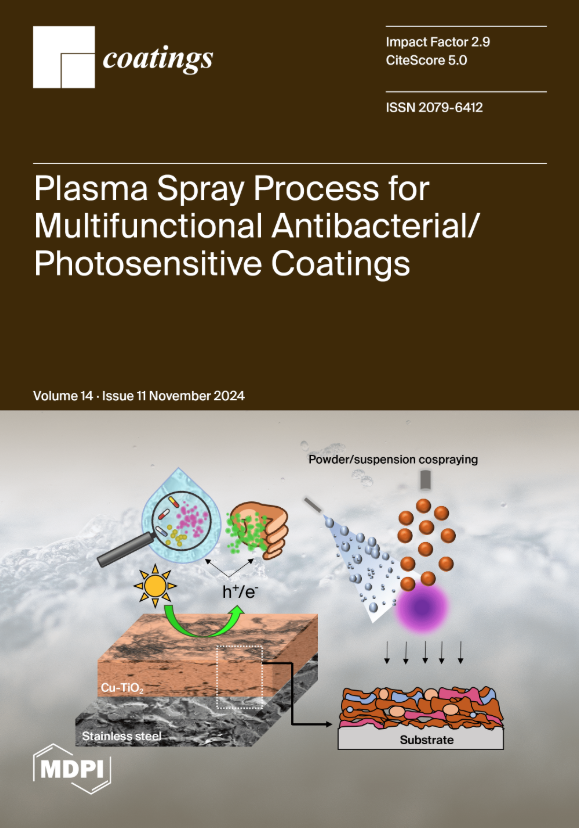Elevated Temperature Tribological Behavior of Duplex Layer CrN/DLC and Nano Multilayer DLC-W Coatings Deposited on Carburized and Hardened 16MnCr5 Steel
IF 2.8
3区 材料科学
Q2 MATERIALS SCIENCE, COATINGS & FILMS
引用次数: 0
Abstract
This study investigates the impact of temperature on the tribological performance of duplex layer CrN/DLC and nano-multilayers DLC-W coatings deposited using hybrid PVD-PECVD techniques on carburized and hardened 16MnCr5 discs cut from internal combustion engines valve tappets. Reciprocating dry sliding experiments were conducted at 25 °C, 150 °C, 200 °C, and 250 °C to analyze the high-temperature tribological behavior of the coatings. The wear mechanisms were characterized using SEM, EDS mapping, Raman spectroscopy, and nanoindentation. The lowest coefficient of friction was obtained for CrN/DLC at 25 °C. The CrN/DLC coefficients of friction (COF) increase with temperatures due to increasing adhesive wear. Similarly, DLC-W exhibited a comparable trend with increasing temperature from 25 °C to 250 °C. Both coatings’ wear resistance decreased with higher temperatures due to the transformation of sp3 C bonds to sp2 C bonds, facilitating the plastic deformation of the coatings and afterward of the substrate. The CrN/DLC displayed superior wear resistance to the DLC-W coating across all temperatures. The DLC-W multilayer coating showed poor wear resistance above 150 °C, being completely removed during the testing. Compared to both coatings, the uncoated 16MnCr5 discs exhibited higher coefficients of friction and wear rates at all temperatures. Predominant wear mechanisms observed in the coated discs were adhesive and abrasive. The study revealed a decrease in the coatings’ structural and mechanical properties with rising temperatures. Hard abrasive WC particles were identified as contributing to increased wear rates in the multilayer DLC-W coatings.渗碳和硬化 16MnCr5 钢上沉积的双相层 CrN/DLC 和纳米多层 DLC-W 涂层的高温摩擦学行为
本研究探讨了温度对采用 PVD-PECVD 混合技术沉积在从内燃机气门挺杆上切割下来的渗碳和硬化 16MnCr5 盘上的双相层 CrN/DLC 和纳米多层 DLC-W 涂层的摩擦学性能的影响。在 25 ℃、150 ℃、200 ℃ 和 250 ℃ 下进行了往复式干滑动实验,以分析涂层的高温摩擦学行为。使用扫描电镜、EDS 图谱、拉曼光谱和纳米压痕法对磨损机制进行了表征。在 25 °C 时,CrN/DLC 的摩擦系数最低。由于粘合磨损加剧,CrN/DLC 的摩擦系数(COF)随温度升高而增大。同样,DLC-W 在 25 °C 至 250 °C 的温度升高过程中也表现出类似的趋势。两种涂层的耐磨性都随着温度升高而降低,这是由于 sp3 C 键转变为 sp2 C 键,从而促进了涂层的塑性变形,之后又促进了基体的塑性变形。在所有温度下,CrN/DLC 的耐磨性都优于 DLC-W 涂层。DLC-W 多层涂层在 150 °C 以上的耐磨性较差,在测试过程中被完全去除。与这两种涂层相比,未涂层的 16MnCr5 盘在所有温度下都表现出更高的摩擦系数和磨损率。在涂层圆盘上观察到的主要磨损机制是粘着磨损和研磨磨损。研究表明,涂层的结构和机械性能随着温度的升高而降低。在多层 DLC-W 涂层中,硬质磨料 WC 颗粒被认为是导致磨损率增加的原因。
本文章由计算机程序翻译,如有差异,请以英文原文为准。
求助全文
约1分钟内获得全文
求助全文
来源期刊

Coatings
Materials Science-Surfaces, Coatings and Films
CiteScore
5.00
自引率
11.80%
发文量
1657
审稿时长
1.4 months
期刊介绍:
Coatings is an international, peer-reviewed open access journal of coatings and surface engineering. It publishes reviews, research articles, communications and technical notes. Our aim is to encourage scientists to publish their experimental and theoretical results in as much detail as possible. There is no restriction on the length of the papers. Full experimental and/or methodical details must be provided. There are, in addition, unique features of this journal:
* manuscripts regarding research proposals and research ideas will be particularly welcomed
* electronic files or software regarding the full details of the calculation and experimental procedure - if unable to be published in a normal way - can be deposited as supplementary material
 求助内容:
求助内容: 应助结果提醒方式:
应助结果提醒方式:


